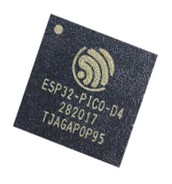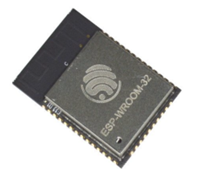ESP32 PICO and ESP32 WROOM are the ESP32 modules that are used on the System on chips and development boards. They have their respective uses and unique features. They do not differ much in terms of technical specifications, but they mainly differ in size and usage.
ESP32 PICO
The ESP32 PICO is a small microcontroller chip that consists of two low-power Xtensa 32-bit LX6 microprocessors. It uses a 4 MB SPI flash that enhances its memory and storage capacity. It has robust performance and little consumption of power, which makes it suitable for power-saving devices. Different versions of ESP32 PICO are used in development boards. These are.
- ESP32-PICO-D4
- ESP32-PICO-MINI-02
- ESP32-PICO-MINI-02U
- ESP32-PICO-V3-ZERO
- ESP32-PICO-DU1906
- ESP32-PICO-DU1906-U
Main Highlights of ESP32 PICO
The main features of ESP32 PICO include:
- Wi-Fi (IEEE 802.11 b/g/n) and Bluetooth LE
- 40 MHz Crystal Oscillator
- 448 KB ROM
- 512 KB SRAM
- 8 KB Fast RTC and 8 KB Slow RTC
- GPIO, I2C, SPI, and UART pins
- Operating Voltage = 3.3 to 3.6 V
ESP32 WROOM
The ESP32 WROOM is a microcontroller module used on ESP32 development boards and SoCs. It has a dual-core 32-bit LX6 microprocessor that operates at 240MHz. It is a highly integrated device with Wi-Fi, Bluetooth dual mode, RF receiver, transmitter, and filters embedded in it. Furthermore, it is also a low-power consumption module. The different versions of ESP32 WROOM that are used in ESP32 boards are as follows.
- ESP32-WROOM-32
- ESP32-WROOM-32D-16 MB
- ESP32-WROOM-32D-4MBHT
- ESP32-WROOM-32E
- ESP32-WROOM-32U-16 MB
- ESP32-WROOM-32U-4MBHT
- ESP32-WROOM-32UE
- ESP32-WROVER-E
Main Highlights of ESP32 WROOM
The main features of ESP32 WROOM include:
- Wi-Fi (IEEE 802.11 b/g/n), Bluetooth BR/EDR, and Bluetooth LE
- 40 MHz Crystal Oscillator
- 448 KB ROM
- 512 KB SRAM
- 8 KB Fast RTC and 8 KB Slow RTC
- GPIO, I2C, SPI, and UART pins
- Operating Voltage = 3.3 to 3.6 V
Differences Between ESP32 PICO and ESP32 WROOM
As stated above, ESP32 PICO and ESP32 WROOM do not vary much in specifications, but some features distinguish the two. These differences are given below.
Physical Dimensions
The major difference between ESP32 PICO and ESP32 WROOM is their physical size. The ESP32 PICO is a very tiny chip with dimensions of only (7.000±0.100) mm × (7.000±0.100) mm × (0.940±0.100) mm. Due to its ultimate small size, it occupies a very tiny space on a Printed Circuit Board. It can also effortlessly integrate other components like filters and oscillators.
The ESP32 WROOM is not large in itself however, when compared to the ESP32 PICO it is larger in dimensions. It is 18 mm x 20 mm x 3 mm in size.
Antenna
The ESP32 WROOM 32E has an onboard PCB antenna that is used for communication purposes. The ESP32 WROOM’s other variants can also support an external antenna. On the other hand, the ESP32 PICO does not support an antenna.
Sensors
The ESP32 WROOM has capacitive touch sensors, whereas the ESP32 PICO has an on-chip Hall sensor. However, both of them have on-chip temperature sensors.
SPI Flash
The SPI Flash is a flagship feature of ESP32 PICO, and it is not present in ESP32 WROOM. The ESP32 supports an external 4 MB SPI flash for increased data storage and firmware installation. This flash can be used both by CPU instruction and read-only memory at the same time. The important thing is that it comes in a 7 mm x 7 mm QFN package, which makes it very useful.
Certifications
The ESP32 WROOM has three certifications which include Bluetooth Certification, RF Certification, and Green Certification. On the other hand, ESP32 PICO is only Bluetooth Certified.
Applications
The ESP32 WROOM is used in speech recognition, voice encoding, image recognition, music streaming, automation, and smart buildings. The ESP32 PICO is used in medical equipment, automation, different kinds of sensing equipment, and wearable electronics such as watches.
Conclusion
The ESP32 WROOM and ESP32 PICO are very useful microcontroller modules with unique features. The ESP32 PICO is considered to be of greater value due to its mini size and greater memory due to SPI flash. However, the ESP WROOM module is more readily used in most microcontroller boards due to its high integration capability.


